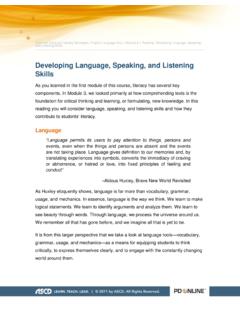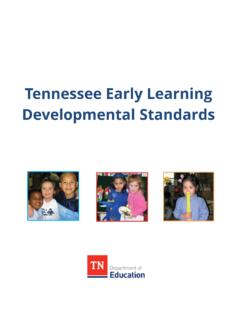Transcription of An Educators Guide for How to Catch a Leprechaun - …
1 An Educator s Guide for How to Catch a Leprechaun Written by Adam Wallace and Illustrated by Andy Elkerton A Common Core State Standards Aligned Activity Guide for Grades Kindergarten, 1 and 2. Note: The activities in this Guide align with Common Core State Standards for English Language Arts for Grades Kindergarten, 1 and 2, but standards for other grades may also apply. Prepared by We Love Children's Books About the Book You've been planning night and day, and finally you've created the perfect trap! Now all you need to do is wait. Is this the year you'll finally Catch the Leprechaun ? Start a St. Patrick's Day tradition with this fun and lively children's book. How to Catch a Leprechaun ? It's tougher than you think! He'll turn your whole house upside down. He's quicker than a wink! About the Author and Illustrator Adam Wallace is the New York Times bestselling author of the How to Catch a series. He says that he loves writing stories that make children laugh and get excited about reading and drawing and writing.
2 Visit him at: Andy Elkerton is New York Times bestselling illustrator of the How to Catch a series. He is based in the village of Taynuilt, on the West coast of Scotland. He worked in the field of computer games, but now is finally doing what he always wanted to children's books! Visit him at: Childrens-Illustrator-187820837936476/. Pre-Reading Questions and Activities Have students ever heard of a Leprechaun before? What other stories do they know about leprechauns? What books or shows do students know that feature leprechauns? In this book, the Leprechaun plays tricks on people for St. Patrick's Day. Why are @sourcebookskids An Educator s Guide for How to Catch a Leprechaun leprechauns associated with St. Patrick's Day? Do students and their families have any St. Patrick's Day traditions? Do leprechauns visit on St. Patrick's Day? Have students ever set a trap for a Leprechaun ? Vocabulary While you read the story aloud to the class, have students identify unfamiliar words and create a vocabulary list to go along with the book.
3 define the words as a class using an array of strategies to determine meaning , including context , accompanying illustrations in the story and the dictionary if needed. Provide real-life connections to these new words by discussing other situations where they could be used. Have students practice using these new words in a sentence. Can students think of other words that could be used that have similar meanings? RL L , , , , , Post-Reading Questions and Activities It's a trap! Break students into small groups and assign each group one of the traps from the book for closer study. In this book, each child works alone to set a trap for the Leprechaun . How does the Leprechaun elude their traps? Have each group share their findings with the class. What trap makes the most sense to students? RL , , , , , , , SL , , , , , , , , The Last House The final house has many different traps and readers can see them through the windows before the Leprechaun goes inside. After the Leprechaun escapes, the traps are left in ruins.
4 Break the class into groups and assign each group one trap. Have them figure out how they think it worked and locate the ruined remains of it in the illustration of the Leprechaun 's escape. They should also theorize how the Leprechaun defeated the trap. Have each group present their ideas to the class. SL K1, , , , , , , , Looks Like It Sounds Have students noticed that certain words on each page of this story are written in a different style and color? Why do students think these specific words were chosen to be highlighted? How does the way they appear reflect their meaning or help the illustration on that page to tell the story? Ask for volunteers to read a page aloud and pronounce the word in a way that reflects its meaning and fancy appearance. RL , , , , , SL , , , , , @sourcebookskids An Educator s Guide for How to Catch a Leprechaun Why? What does the Leprechaun have that makes children want to Catch him? Could there more than one reason they set traps? Come together as a class and discuss the sorts of pranks the Leprechaun pulls.
5 How would students react if he did that in their houses? How would their parents react? Besides leaving a mess and playing pranks, what else does the Leprechaun leave behind? Why might his leaving gold (chocolate?) coins make the children want to Catch him? RL , , , , , , , , SL , , , , , How to Catch a Leprechaun Have students design and draw their own trap to Catch the Leprechaun . How does it work? How does the Leprechaun elude it? Working with an adult, have students write rhyming text that tells what is happening, like in the book. Have volunteers present their work to the class. Compile all these new pages and send them to the author and illustrator along with a letter to let them know how much the class enjoyed reading their book! W , , SL , , , , , Compare and Contrast One of the fun things about the How to Catch books is that each one is a little different, but they share common features across the series. Compare How to Catch a Leprechaun with How to Catch an Elf. How are these stories similar?
6 How are they different? Discuss the motivation of the children between the two books. Would students be more interested to Catch the Leprechaun or the elf? Why? RL , , , , , , , , , , SL , , , , , Rube Goldberg Machines In one house, there is a very complex trap with many crazy parts: a glove on a stick, a cup of tea, boots on a pinwheel, a bowling ball, and more! Break students into small groups and have them study this page. Did the child build this trap alone, or did she have help? What in the book makes them think that? How was this trap supposed to work? Come together as a class and discuss their findings. Have students ever heard of a Rube Goldberg machine Look up information on Rube Goldberg and Rube Goldberg machines on the internet. Inspired by this research, have the whole class work together to design the craziest, most complex trap they can! Did any other books have similarly complex devices? RL , , , , , W , , , , , SL , , , , , Visit the Common Core State Standards website to read about the individual standards listed in this Guide : @sourcebookskids An Educator s Guide for How to Catch a Leprechaun For Reference Common Core State Standards Used Reading Standards for Literature KINDERGARTEN (RL).
7 Key Ideas and Details With prompting and support, ask and answer questions about key details in a text. With prompting and support, identify characters, settings and major events in a story. Craft and Structure Ask and answer questions about unknown words in a text. With prompting and support, name the author and illustrator of a story and define the role of each in telling the story Integration of Knowledge and Ideas With prompting and support, describe the relationship between illustrations and the story in which they appear ( , what moment in a story an illustration depicts). With prompting and support, compare and contrast the adventures and experiences of characters in familiar stories Writing Standards KINDERGARTEN (W). Text Types and Purposes Use a combination of drawing, dictating, and writing to narrate a single event or several loosely linked events, tell about the events in the order in which they occurred, and provide a reaction to what happened. Research to Build and Present Knowledge Participate in shared research and writing projects ( , explore a number of books by a favorite author and express opinions about them).
8 With guidance and support from adults, recall information from experiences or gather information from provided sources to answer a question. Speaking and Listening Standards KINDERGARTEN (SL). Comprehension and Collaboration Participate in collaborative conversations with diverse partners about kindergarten topics and texts with peers and adults in small and larger groups. a. Follow agreed-upon rules for discussions ( , listening to others and taking turns speaking about the topics and texts under discussion). b. Continue a conversation through multiple exchanges Confirm understanding of a text read aloud or information presented orally or through other media by asking and answering questions about key details and requesting clarification if something is not understood. @sourcebookskids An Educator s Guide for How to Catch a Leprechaun Presentation of Knowledge and Ideas Describe familiar people, places, things and events and, with prompting and support, provide additional detail.
9 Add drawings or other visual displays to descriptions as desired to provide additional detail. Language Standards KINDERGARTEN (L). Vocabulary Acquisition and Use Determine or clarify the meaning of unknown and multiple- meaning words and phrases based on kindergarten reading and content. a. Identify new meanings for familiar words and apply them accurately ( , knowing duck is a bird and learning the verb to duck). b. Use the most frequently occurring inflections and affixes ( , -ed, -s, re-, un-, pre-, -ful, -less) as a clue to the meaning of an unknown word. With guidance and support from adults, explore word relationships and nuances in word meanings. a. Sort common objects into categories ( , shapes, foods) to gain a sense of the concepts the categories represent. b. Demonstrate understanding of frequently occurring verbs and adjectives by relating them to their opposites (antonyms). c. Identify real-life connections between words and their use ( , note places at school that are colorful).
10 D. Distinguish shades of meaning among verbs describing the same general action ( , walk, march, strut, prance) by acting out the meanings Reading Standards for Literature Grade 1 (RL). Key Ideas and Details Ask and answer questions about key details in a text. Retell stories, including key details, and demonstrate understanding of their central message or lesson. Describe characters, settings, and major events in a story, using key details. Integration of Knowledge and Ideas Use illustrations and details in a story to describe its characters, setting, or events. Compare and contrast the adventures and experiences of characters in stories. Writing Standards Grade 1 (W). Text Types and Purposes Write narratives in which they recount two or more appropriately sequenced events, include some details regarding what happened, use temporal words to signal event order, and provide some sense of closure. @sourcebookskids An Educator s Guide for How to Catch a Leprechaun Research to Build and Present Knowledge Participate in shared research and writing projects ( , explore a number of how-to.)




